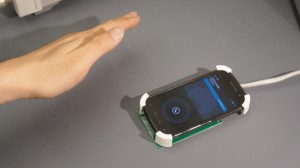“With almost all of the U.S. population armed with cellphones – and close to 80 percent carrying a smartphone – mobile phones have become second-nature for most people.
“What’s coming next, say University of Washington researchers, is the ability to interact with our devices not just with touchscreens, but through gestures in the space around the phone. Some smartphones are starting to incorporate 3-D gesture sensing based on cameras, for example, but cameras consume significant battery power and require a clear view of the user’s hands.
“UW engineers have developed a new form of low-power wireless sensing technology that could soon contribute to this growing field by letting users ‘train’ their smartphones to recognize and respond to specific hand gestures near the phone.
“The technology – developed in the labs of Matt Reynolds and Shwetak Patel, UW associate professors of electrical engineering and of computer science and engineering – uses the phone’s wireless transmissions to sense nearby gestures, so it works when a device is out of sight in a pocket or bag and could easily be built into future smartphones and tablets.”
Read more here. Learn more about the project here. (In addition to Matt and Shwetak, project members are graduate students Chen Zhao, Ke-Yu Chen, and Md Tanvir Islam Aumi.)


